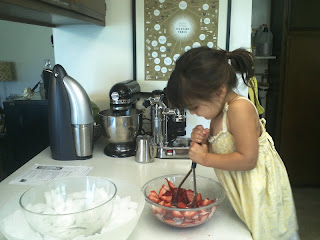Beatrice says so many wild things every day I almost feel silly trying to capture them here on the blog anymore. Lately she's told Dev and me that the clouds are pink at sunset because the sun is driving his pink car to Target to go get green meat for his dogs, that there are groups of mice that disguise themselves as chandeliers in order to steal food from babies, that fairies leave dew on the lawn in the morning to give wine to worms, and that some owls she saw at the Dallas Aquarium were sad because they missed their mother who had gone off to work at a balloon factory. She also told Dev this morning to "please speak quietly" and "go play someplace else" because she had to make a "business phone call." She then proceeded to call In n' Out on her play phone and pitch to them her new invention, green french fries with "color-changing hair."
Beatrice is pretending to breastfeed the doll under her shirt.
What's more, Beatrice is not Beatrice anymore but "Olivia" (or occasionally, "Penny," "Llama," or "The Pigeon") - she absolutely insists on everyone calling her Olivia after the little piglet character from the books and TV show. And whenever she changes her own name she changes all of ours, too, so Arthur becomes Olivia's little brother William (or occasionally Ian, as Olivia has two brothers); Dev is simply "Olivia's Dad;" I am Mathilda, Olivia's stuffed toy companion; and even Shackleton and Cromwell are renamed as Perry (Olivia's dog) and Edwin (Olivia's cat). Other people in Beatrice's life play supporting parts, from Mrs. Hoggenmueller to Uncle Garrett. In fact, whenever Beatrice shows up at school in the morning now her teacher Mr. Ricardo asks her, "Who are you today?"
Beatrice also has an imaginary friend, an imaginary older sister, and an imaginary infant. The infant is named Baby Franny and Beatrice is constantly telling us to keep the noise down while Baby Franny is sleeping. Baby Franny is often sick and requires near daily visits to the pediatrician.
You may remember Arthur was
an owl for Halloween last year. Ask Beatrice now and she will tell you that she vividly remembers when Arthur put on his owl costume and then flew up in the sky, and she will tell you all about how he flew above us and we all clapped and waved and how all her school friends came to see Arthur flying around, and how he hooted like an owl, and on and on.
Most of these far-out stories are just for fun, but Beatrice also uses imaginary games to work through real-life issues that are bothering her. Somewhat heartbreakingly, she projects her own worries and fears onto stuffed animals, dolls, and storybook characters. Just today, for example, she said about the stuffed duck she was cradling, "William the duck is very brave, he isn't scared of swimming in a pool. But he is a little sad because he misses his mimi [pacifier]. He gave it away to the hospital babies but now he misses it and wants it back. Maybe it would feel him better if we went to Target and got him some new mimis for his birthday. He can't have his old mimis, they are at the hospital now, but he might like a new one for his birthday...." and so on.
Of course, not all of Beatrice's imaginings are as sweet and mild as pink sunset cars and solicitous dew fairies. For someone who has never seen a violent cartoon or read a violent story or even picked up a water gun, she imagines some very weird, dark things. Just today she said about an imaginary friend, "I love him so much, I am going to eat him up, and tear him apart with my sharp teeth."
Another time, she used stickers to cover the faces of the characters in one of her picture books. I asked her, "Why did you put stickers on all their faces?"
"I buried their eyes," she said.
Even more disturbing was a conversation we had shortly after Beatrice transferred into the next grade in preschool, a transition that was extremely difficult for her:
Summer: So do you like your new friends in the Green Room?
Beatrice: They are nice, but they don't blink.
Summer: They don't blink?
Beatrice: Their eyes are just glued on their faces.
Definite horror movie material there. But as creepy as these things are, I've always believed that children are naturally drawn to dark and violent images that mythologize the many anxieties and fears of early childhood, and that drama and imaginative play are great ways to transmute these fears and anxieties into manageable forms. Or maybe I'm just telling myself that so I don't worry that Beatrice is a dangerous lunatic.




































































